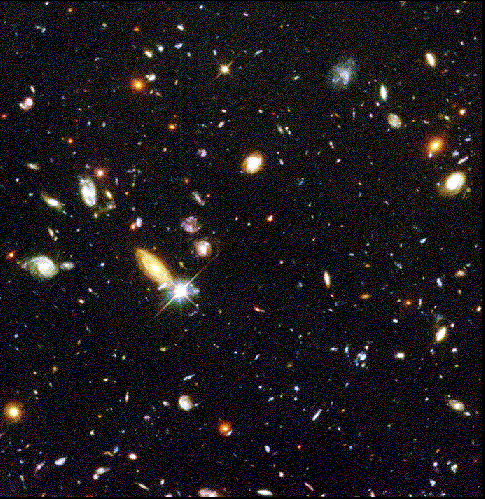

 The Sun is a star! This is a basic fact which is very often overlooked.
The Sun is such a familiar object in the sky that its family
connections to the nocturnal bodies we call stars are seldom
appreciated. To the casual observer the Sun looks very different
from a star. The Sun appears as a large golden disk in the daytime
sky, while the stars twinkle
as pinpoints of light in the night sky. To all appearances the Sun
seems unique and for life on earth there is no other star like it.
The Sun is the source of energy which sustains all life on planet
earth. It is the earth's universal timekeeper, governing the seasons,
the harvests, even the sleep patterns of the creatures populating our
planet. Yet, the Sun is a star, one of 100 billion in our galaxy alone.
With the universe containing 100 billion galaxies, each filled with
stars, we see that our Sun is merely one infinitesimal part of the
immensity we call the
universe.
That it has a planetary system which
can support life may yet prove to be its sole unique feature.
The Sun is a star! This is a basic fact which is very often overlooked.
The Sun is such a familiar object in the sky that its family
connections to the nocturnal bodies we call stars are seldom
appreciated. To the casual observer the Sun looks very different
from a star. The Sun appears as a large golden disk in the daytime
sky, while the stars twinkle
as pinpoints of light in the night sky. To all appearances the Sun
seems unique and for life on earth there is no other star like it.
The Sun is the source of energy which sustains all life on planet
earth. It is the earth's universal timekeeper, governing the seasons,
the harvests, even the sleep patterns of the creatures populating our
planet. Yet, the Sun is a star, one of 100 billion in our galaxy alone.
With the universe containing 100 billion galaxies, each filled with
stars, we see that our Sun is merely one infinitesimal part of the
immensity we call the
universe.
That it has a planetary system which
can support life may yet prove to be its sole unique feature.
 As stars go, however, the Sun is rather mediocre. It is
classed as a yellow dwarf star,
and is, as far as we know, a single star system. Given the multitude
of giant stars, multiple stars, pulsating stars, and black holes which
populate the universe, the Sun,
at least, appears to have chosen a quiet neighbourhood in which to
live a quiet life. The Sun lies some 32,000 light years from the
center of our galaxy and takes 225 million years to complete one
orbit of the galactic center. (A light year is the distance that
light, travelling at 300,000 km/s, can cover in one year. One light
year is equivalent to 9 trillion kilometers.)
As stars go, however, the Sun is rather mediocre. It is
classed as a yellow dwarf star,
and is, as far as we know, a single star system. Given the multitude
of giant stars, multiple stars, pulsating stars, and black holes which
populate the universe, the Sun,
at least, appears to have chosen a quiet neighbourhood in which to
live a quiet life. The Sun lies some 32,000 light years from the
center of our galaxy and takes 225 million years to complete one
orbit of the galactic center. (A light year is the distance that
light, travelling at 300,000 km/s, can cover in one year. One light
year is equivalent to 9 trillion kilometers.)


Go to the Solar Classroom
Last Updated: April 10, 1997